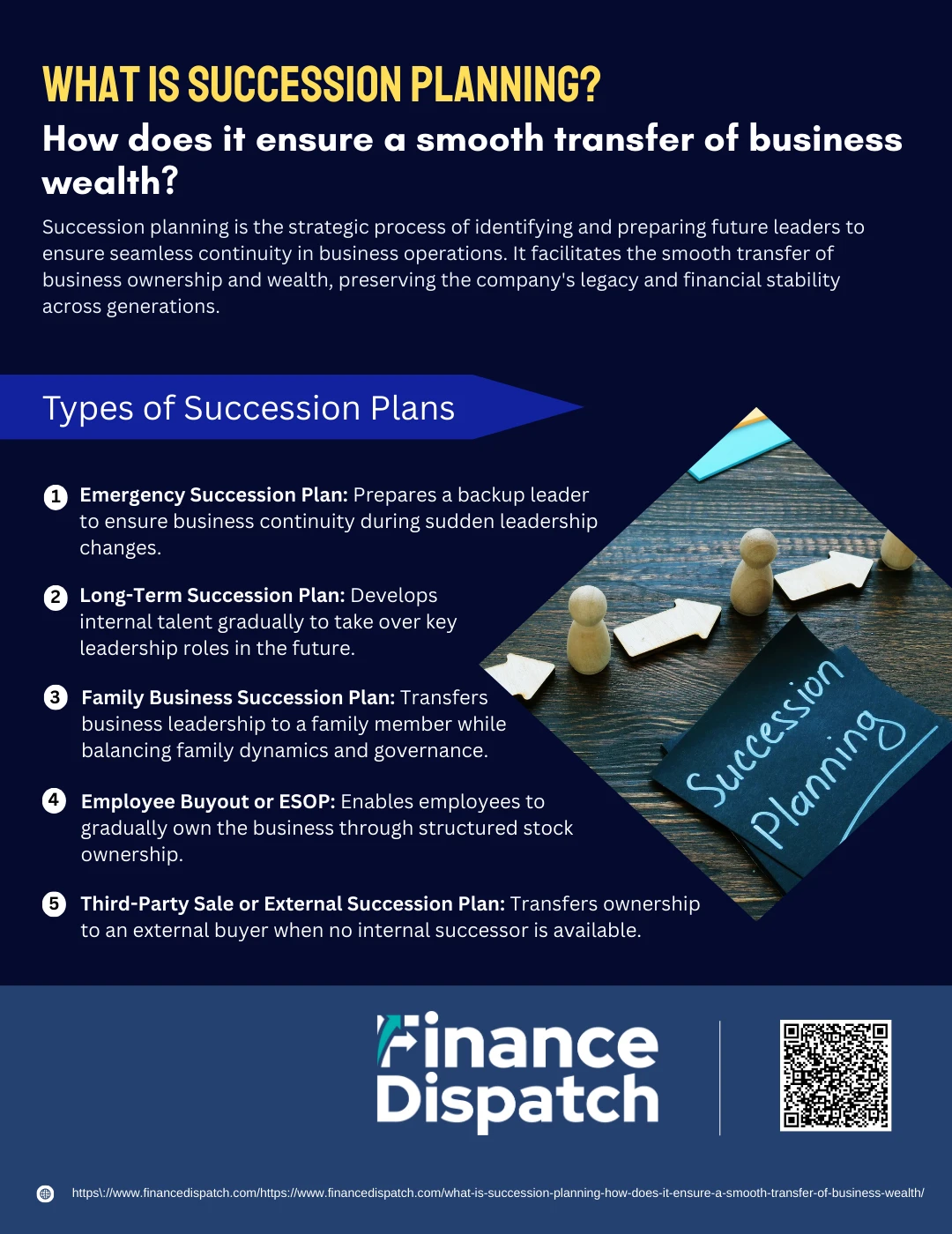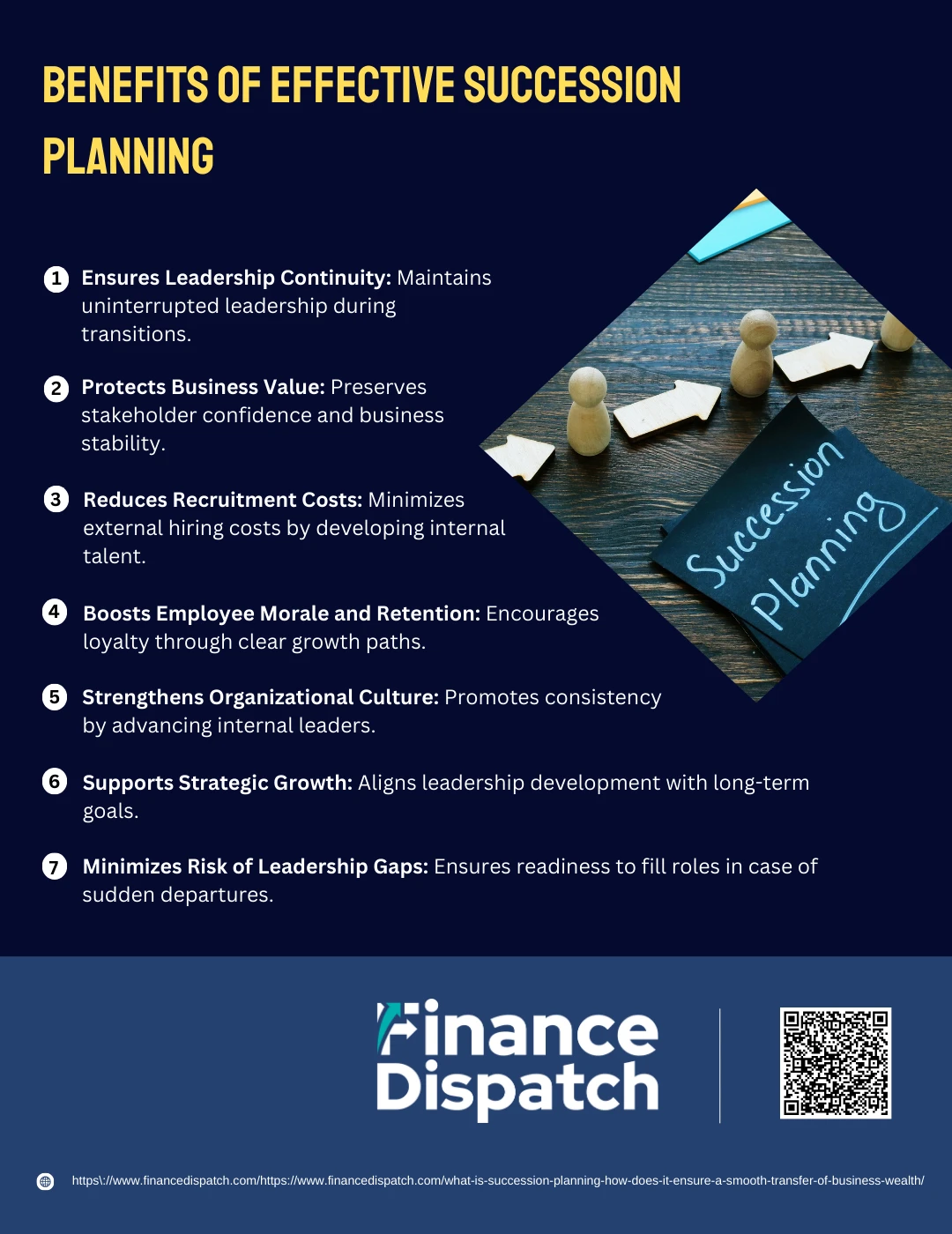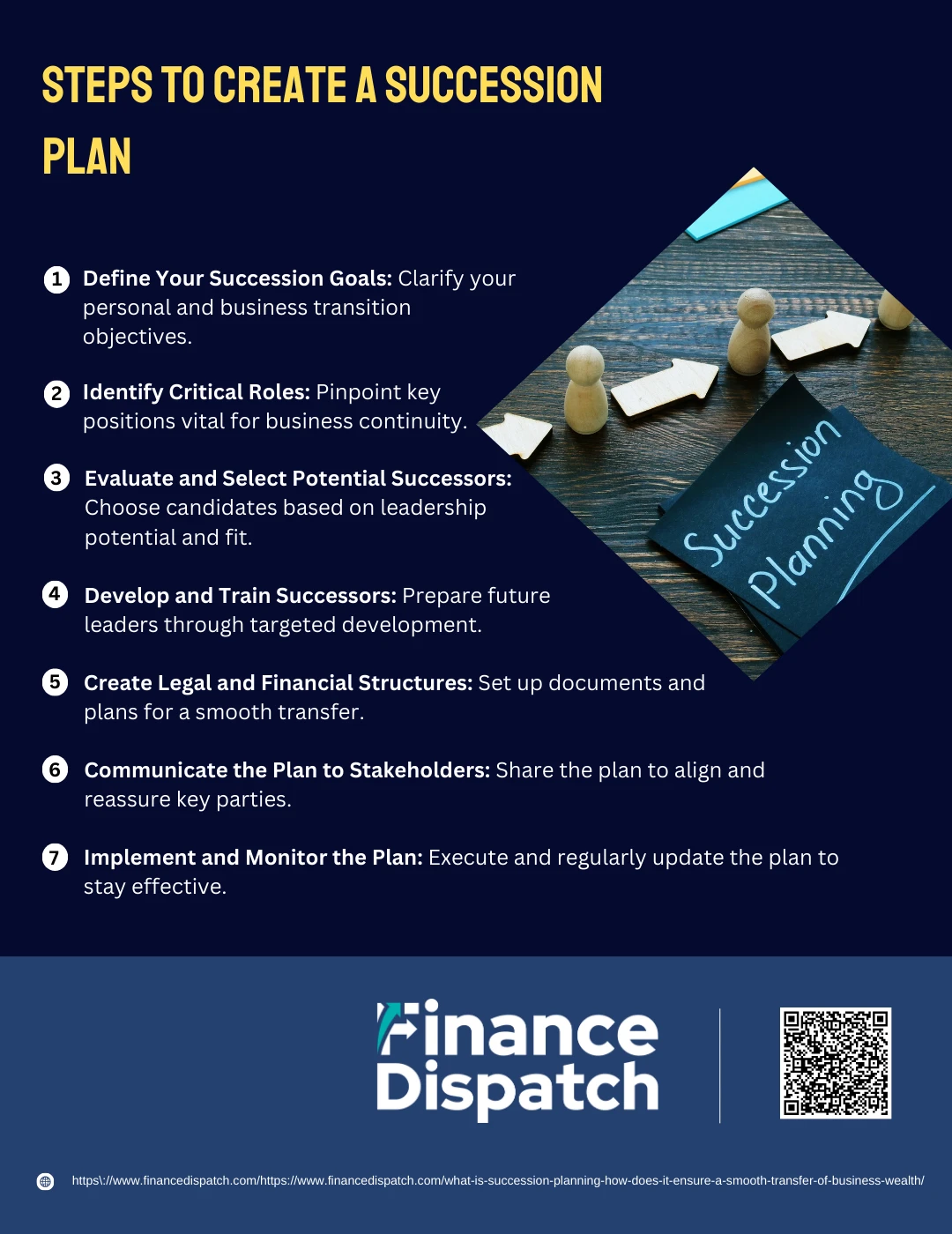Succession planning is a strategic process that prepares businesses for the eventual transition of leadership or ownership. Whether due to retirement, unforeseen circumstances, or a planned exit, having a well-crafted succession plan ensures that your business continues to operate smoothly without disruption. More than just choosing a successor, it involves developing leadership, protecting company value, and coordinating financial and legal strategies for wealth transfer. In today’s competitive landscape, succession planning is not only essential for preserving a company’s legacy—it’s a critical step toward securing long-term stability and sustaining generational wealth.
What is Succession Planning?
Succession planning is the process of identifying and preparing individuals to take over key roles within a business when current leaders step down, retire, or are unexpectedly unable to continue. It involves evaluating leadership needs, selecting potential successors, and providing them with the necessary training and experience to ensure they are ready to lead. Far from being a one-time task, succession planning is an ongoing strategy that aligns leadership development with the company’s long-term goals. Whether transitioning ownership within a family, to employees, or external buyers, a solid succession plan lays the foundation for business continuity and sustained success.
Why is Succession Planning Important?
Succession planning is vital because it ensures a business remains stable and resilient during times of leadership transition. Without a clear plan, companies risk operational disruptions, loss of client trust, and a decline in business value. A well-structured succession plan prepares future leaders in advance, reduces dependency on a single individual, and maintains continuity in decision-making and company vision. It also empowers employees by offering growth opportunities and helps business owners preserve their legacy while protecting the wealth they’ve built. In essence, succession planning safeguards both the people and the financial future of the organization.
How Succession Planning Ensures Smooth Transfer of Business Wealth
A well-designed succession plan not only prepares new leadership but also plays a key role in preserving and transferring business wealth effectively. By aligning operational continuity with legal, financial, and tax strategies, succession planning minimizes disruptions, protects the company’s value, and ensures that ownership and assets transition efficiently to the next generation or designated successors. It helps avoid family conflicts, reduces tax liabilities, and supports long-term financial security for both the business and its stakeholders.
Here’s a table illustrating how specific succession planning strategies contribute to a smooth wealth transfer:
| Succession Strategy | Wealth Transfer Benefit |
| Use of Trusts and Buy-Sell Agreements | Minimizes estate taxes, avoids probate, and provides clear terms for asset distribution |
| Early Successor Identification | Preserves operational stability, prevents loss of business value during leadership changes |
| Business Valuation and Tax Planning | Ensures accurate pricing, reduces capital gains and inheritance tax exposure |
| Leadership Development Programs | Builds capable successors, preserving confidence of clients, employees, and investors |
| Clear Communication and Documentation | Prevents misunderstandings and legal disputes, safeguarding both business continuity and value |
| Involvement of Financial Advisors | Enables tax-efficient transfer, retirement planning, and liquidity management |
 Types of Succession Plans
Types of Succession Plans
Succession planning isn’t a one-size-fits-all approach. Businesses differ in structure, leadership, and future goals, so the type of succession plan should be tailored to fit those unique needs. Whether preparing for an unexpected crisis or a long-anticipated retirement, having the right succession plan in place helps protect business continuity, retain company value, and ensure a smooth leadership transition.
1. Emergency Succession Plan
This plan is designed to address sudden and unforeseen events such as the death, illness, or resignation of a key leader. It ensures that someone is immediately available to step into the role, either temporarily or permanently, to avoid disruption. It includes identifying backup leaders and outlining clear responsibilities for critical positions.
2. Long-Term Succession Plan
A proactive strategy that identifies and prepares future leaders over time. This plan includes structured training, mentorship, and gradual responsibility shifts to ensure candidates are fully equipped to take over key roles. It is ideal for organizations that want to promote internal talent and reduce the risks of leadership gaps.
3. Family Business Succession Plan
In family-owned businesses, succession often involves transferring leadership or ownership to a family member. This type of plan balances personal relationships with professional responsibilities and often requires family governance policies, open communication, and estate planning to ensure a successful generational transition.
4. Employee Buyout or ESOP (Employee Stock Ownership Plan)
This plan involves selling the business to its employees, typically through a structured stock ownership program. It rewards loyalty and institutional knowledge while maintaining company culture. ESOPs can also provide a smooth and tax-advantaged exit strategy for business owners.
5. Third-Party Sale or External Succession Plan
When no suitable internal successor exists, a business may look to external buyers—such as strategic partners, competitors, or private equity firms. This plan involves business valuation, marketing, and negotiation to find the right buyer who aligns with the company’s values and future potential.
 Benefits of Effective Succession Planning
Benefits of Effective Succession Planning
Succession planning is more than a future-focused exercise—it’s a strategic advantage that strengthens the entire organization. By preparing for leadership transitions in advance, businesses not only avoid operational disruptions but also enhance employee development, preserve company culture, and secure long-term financial success. Whether you’re a small business owner or managing a large corporation, a solid succession plan ensures that your business is ready for change without losing momentum or value.
1. Ensures Leadership Continuity
One of the primary goals of succession planning is to guarantee that leadership roles are filled without delay. This reduces downtime during transitions and allows the business to operate seamlessly, regardless of whether the change is sudden or expected.
2. Protects Business Value
Transitions without planning can lead to uncertainty and a decline in perceived value by stakeholders or potential buyers. A clear succession plan reassures investors, employees, and clients that the business is stable and prepared for the future.
3. Reduces Recruitment Costs
Hiring external executives is expensive and time-consuming. With succession planning, internal candidates are groomed for leadership, saving on recruitment fees, onboarding time, and potential hiring mismatches.
4. Boosts Employee Morale and Retention
When employees see a clear path for growth and advancement, it increases their engagement and loyalty. High-performing team members are more likely to stay with the company when they feel valued and see long-term opportunities.
5. Strengthens Organizational Culture
Promoting leaders from within helps preserve the company’s mission, values, and culture. Internal successors are already familiar with the company’s operations and vision, which promotes consistency and trust among staff and clients.
6. Supports Strategic Growth
Future leaders, when properly trained and mentored, are prepared to drive innovation and expansion. Succession planning aligns leadership capabilities with the company’s long-term strategic goals, making growth more sustainable.
7. Minimizes Risk of Leadership Gaps
Without a succession plan, a sudden leadership departure can leave the business vulnerable. Identifying and preparing backups for key roles ensures the organization can respond quickly and effectively, avoiding disruption.
 Steps to Create a Succession Plan
Steps to Create a Succession Plan
A successful succession plan doesn’t happen overnight. It requires careful thought, collaboration, and execution over time. Whether you’re preparing for a planned retirement, an emergency, or simply ensuring business continuity, having a step-by-step roadmap helps reduce uncertainty, secure your company’s future, and preserve its value. The following steps provide a clear framework to guide you through the process of building a strong succession plan.
1. Define Your Succession Goals
Start by identifying your personal and business objectives. Do you plan to retire at a certain age? Would you prefer to pass the business to a family member, sell it to an employee, or find an external buyer? Clarifying these goals helps align your succession strategy with your long-term vision and ensures you’re planning for the right kind of transition.
2. Identify Critical Roles
Determine which positions are essential for business operations and long-term growth. These typically include executive roles, financial decision-makers, operational leads, or client relationship managers. By focusing on these high-impact roles, you can prioritize where leadership continuity is most crucial.
3. Evaluate and Select Potential Successors
Look within your organization to identify individuals who have shown leadership potential, cultural alignment, and a deep understanding of the business. This could be a family member, a loyal employee, or a promising manager. If no internal candidates are suitable, consider external options. Assess each candidate’s strengths, gaps, and readiness to take on future responsibilities.
4. Develop and Train Successors
Once potential successors are identified, invest in their professional development. This may include leadership training, mentorship, rotating assignments in different departments, or shadowing existing leaders. The goal is to prepare them not just for the role, but for the challenges and decision-making required at the next level.
5. Create Legal and Financial Structures
Work with your legal, financial, and tax advisors to develop essential documentation. This may involve creating a buy-sell agreement, updating ownership documents, establishing trusts, or planning for estate taxes. Proper structuring helps avoid legal conflicts, ensures tax efficiency, and provides clarity on how ownership or shares will be transferred.
6. Communicate the Plan to Stakeholders
A well-communicated plan helps build trust and prevent confusion. Share the plan with key stakeholders such as partners, employees, family members, and clients. Tailor your communication to each group, explaining the purpose, timeline, and how the transition will impact them. Open communication minimizes resistance and aligns everyone with the vision.
7. Implement and Monitor the Plan
Begin implementing the plan gradually by assigning more responsibilities to successors and testing their readiness. Monitor progress through regular reviews and performance evaluations. Business environments change—so your succession plan should be flexible and reviewed annually to ensure it remains relevant and effective.
Financial and Legal Considerations of Succession Planning
Succession planning is not just about choosing the right successor—it also involves managing the financial and legal complexities that come with transferring ownership or leadership. Proper planning in these areas ensures a smooth transition, protects business value, minimizes tax liabilities, and helps avoid disputes among stakeholders. Business owners must work closely with financial advisors, attorneys, and tax professionals to develop a plan that aligns with their long-term goals and complies with legal requirements.
1. Business Valuation: Understanding the true value of your business is critical. A professional valuation ensures fair pricing in a sale or transfer and helps guide decisions about ownership distribution and estate planning.
2. Buy-Sell Agreements: These legal contracts outline how ownership shares will be transferred if an owner retires, dies, or exits the business. They help prevent conflicts and ensure a smooth transition under predefined terms.
3. Trusts and Estate Planning: Trusts, such as revocable or irrevocable trusts, are used to transfer business assets while minimizing probate, taxes, and legal disputes. Estate planning ensures assets are distributed according to the owner’s wishes.
4. Tax Implications: Succession planning should include strategies to reduce capital gains, estate, and inheritance taxes. This can include installment sales, gifting shares over time, or restructuring ownership.
5. Life Insurance for Funding: Life insurance policies can provide liquidity for buying out a deceased partner’s shares or covering estate taxes, helping prevent forced sales of the business.
6. Retirement and Exit Planning: Consider how the owner’s retirement income will be supported—whether through business proceeds, retained shares, or structured payouts—and plan accordingly.
7. Legal Compliance and Documentation: All aspects of the succession plan should be documented and comply with corporate laws, partnership agreements, and employment regulations to ensure enforceability.
Common Mistakes to Avoid in Succession Planning
While succession planning is essential for long-term business stability, many organizations either delay the process or overlook key elements that are critical to its success. Mistakes in succession planning can lead to leadership gaps, internal conflicts, reduced business value, and even failure of the transition altogether. To safeguard your business’s future, it’s important to recognize and avoid the most common pitfalls.
1. Delaying the Planning Process
Many business owners wait too long to start succession planning, leaving them unprepared for unexpected events like illness, retirement, or sudden departures.
2. Failing to Identify and Develop Successors early
Without early identification and grooming of future leaders, businesses may find themselves scrambling to fill critical roles when the need arises.
3. Overlooking Internal Talent
Some organizations automatically look outside for successors without evaluating the capabilities of existing employees, potentially demotivating their workforce and missing loyal, qualified candidates.
4. Lack of a Formal Written Plan
Verbal intentions or vague ideas are not enough. Without a documented and actionable plan, succession efforts can become disorganized and lead to confusion.
5. Ignoring Financial and Tax Planning
A succession plan without proper financial or tax considerations can result in excessive tax liabilities, lost value, or legal complications during ownership transfer.
6. Poor Communication with Stakeholders
Not informing employees, family members, or business partners about the succession plan can lead to resistance, misunderstandings, or lack of alignment with the transition.
7. Assuming One Size Fits All
Each business is unique. Using a generic plan without tailoring it to the organization’s size, industry, structure, and values can make the plan ineffective.
8. Failing to Review and Update the Plan
Business goals, market conditions, and personnel can change. Failing to revisit and revise the plan regularly can render it outdated and ineffective.
Real-world Examples of Successful Succession Planning
Successful succession planning is evident in companies that manage leadership transitions smoothly while maintaining growth, culture, and stakeholder trust. One notable example is Apple Inc., where Steve Jobs’ planned transition to Tim Cook ensured continuity and investor confidence, allowing the company to thrive post-transition. In the family-owned sector, Walmart’s structured handover from founder Sam Walton to his children demonstrated how legacy businesses can sustain generational leadership without compromising strategic goals. Similarly, Ford Motor Company’s leadership planning enabled the appointment of capable successors who upheld the company’s vision while steering it through major industry shifts. These cases highlight how proactive succession planning preserves business value, strengthens internal stability, and lays the foundation for long-term success.
Conclusion
Succession planning is not just a contingency—it’s a strategic necessity for any business that aims to thrive beyond its current leadership. By identifying future leaders, preparing them with the right skills, and aligning financial and legal structures, organizations can ensure a seamless transition that protects both operational stability and business wealth. Whether transferring ownership within a family, to employees, or selling to an external buyer, a well-crafted succession plan preserves your legacy, minimizes disruptions, and secures the long-term success of your enterprise. Starting early and revisiting the plan regularly is the key to a confident and controlled future.



